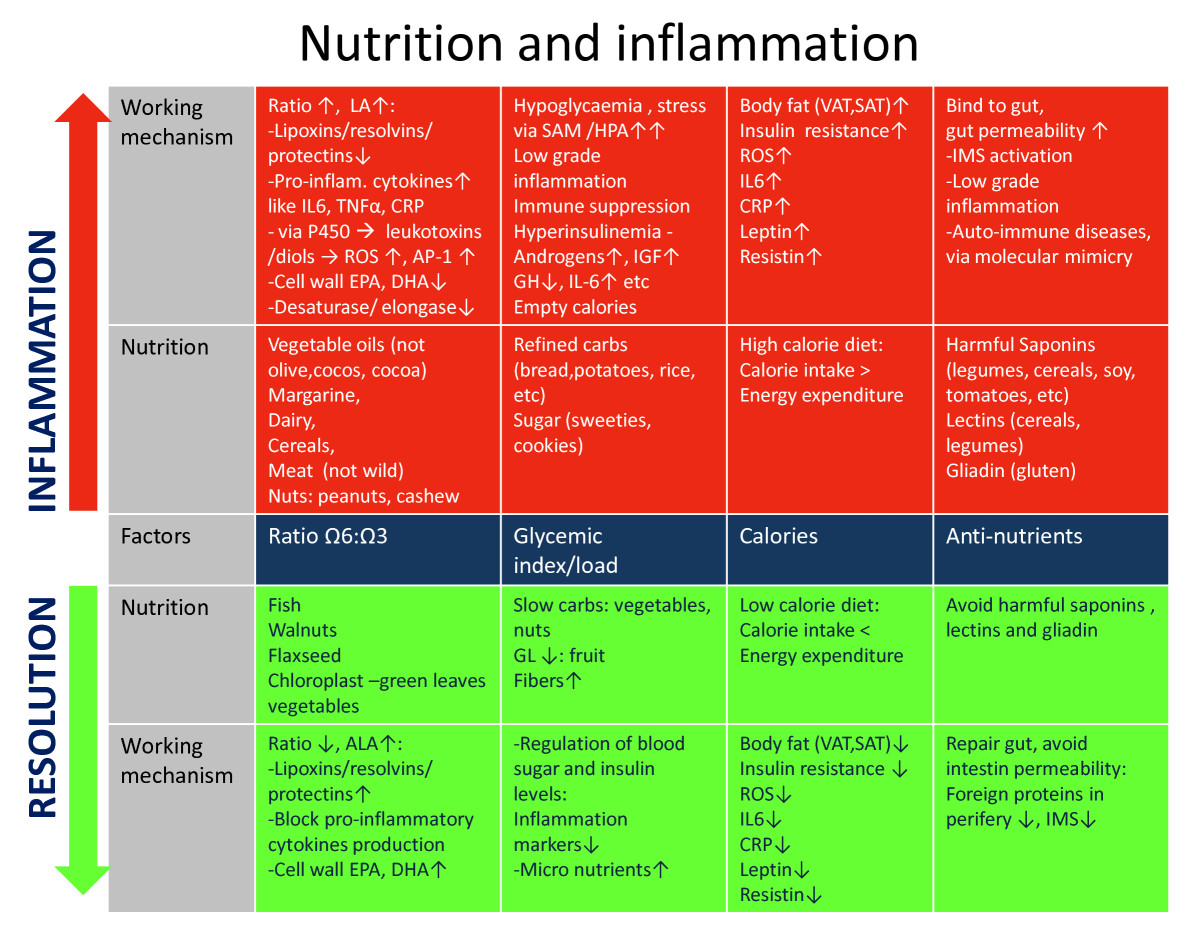TIP: Get guidance from an experienced specialist at the Better Clinic.
Veel mensen lopen rond met (vage) klachten als vermoeidheid, prikkelbaarheid, depressieve gevoelens, weinig energie en een laag libido. Volgens de huisarts en specialist is er niets aan de hand, want er zijn geen afwijkende waarden in het bloed te vinden. Dat is ook niet gek, want de bruikbaarheid van bloedonderzoek is beperkt. Meestal liggen laaggradige ontsteking met bijbehorende insulineresistentie (ongevoeligheid voor het hormoon insuline) aan de basis van deze (vage) klachten. Laaggradige ontsteking is lastig te herkennen in het bloedbeeld. Ten eerste moet je weten naar welke waarden je moet kijken. Ten tweede moet je weten hoe je deze interpreteert. De meeste huisartsen en specialisten zijn hier niet in thuis en zullen jou daarom ook niet de diagnose laaggradige ontsteking geven. De klachten zijn er niet zomaar. Waarom heeft u dit probleem en de buurman niet zeg ik altijd tegen patiënten.
The cause of low-grade inflammation (and chronic symptoms)
To protect you from harmful substances and pathogens, your body has barriers, such as the skin and the mucous membrane of the digestive tract. These barriers normally function as a gatekeeper of the body. They keep all junk out of the body and let only harmless substances in. Poor DPP-IV enzyme activity is detrimental to a healthy body. When a deficiency develops in the presence and activity of the DPP-IV enzyme, it can possibly combine with stress and trauma to cause the gatekeeper system to stop working. This causes increased permeability of the barriers (leaky gut/leaky-gut). Toxins, morphine-like peptides (exorphins), toxins and residues of pathogenic bacteria can thus pass through the intestinal barrier into the blood and poison the body's environment. This is called endotoxin. They disrupt the functioning of our genes and cause epi genetic disorders. They move through the blood-brain barrier into the bloodstream and cause various symptoms in the body. This also explains the number of brain-related disorders. In addition, the endorphin system becomes overloaded due to the decreased breakdown of exorphins and the defect in the production of healthy endorphin receptors. The intrusion of unwanted substances also causes activation of the immune system. As hundreds of different pathogens invade, the immune system is not given permission to go on full attack (fierce immune response) and kill all the pathogens. This would become far too violent an immune response that could lead to death. Therefore, the body chooses to only inhibit the multiplication of the pathogens, limiting the damage they can cause. A mild inflammatory response occurs. As long as the barriers are increased permeable, and junk enters the body, the immune system will remain mildly activated. Like a pilot light. This creates chronic inflammation and is also called low-grade inflammation. Increased gut permeability has been associated with autoimmune diseases, such as type 1 diabetes, rheumatoid arthritis, multiple sclerosis (MS), and diseases associated with chronic inflammation, such as inflammatory bowel disease (Crohn's, ulcerative colitis), asthma, chronic fatigue syndrome and depression.
Low-grade inflammation
The result of a leaky gut is usually low grade inflammation. In the scientific literature, this is also called low grade inflammation. Low grade inflammation is a continuous slight activation of the immune system. This means that the immune system is continuously on. When there is danger, the immune system is activated. The immune system can respond in three ways, mild immune response, severe immune response or overreaction. An example of a mild immune response is low-grade inflammation. A severe immune response is, for example, fever or inflammation resulting from a bacterial infection. In sepsis, there can be an overreaction of the immune system causing so much damage that it can lead to death. A severe immune response aims to kill pathogens. In contrast, a mild immune response does not aim to kill pathogens, but to control them. By inhibiting the pathogens from multiplying, it limits the damage they can do.
What determines the intensity of the immune response?
The brain decides how strong the immune system is going to respond. This decision depends on whether the cost of that decision outweighs (is smaller or equal) the benefit of the reaction. A vigorous immune response takes a lot of energy and does a lot of damage. Whereas a mild immune response costs less energy and also does less damage. A violent reaction is not always desired. The immune system should get permission for a severe reaction only if the body is also able to end this reaction in time. If the reaction is not terminated in time, death can result. For the timely termination of an immune reaction, the omega-3 fatty acids EPA and DHA, among others, are essential. These fatty acids are found primarily in fish and seafood. EPA and DHA are converted into resolvins and protectins that are able to stop an inflammatory response. To choose the right immune response, it first determines whether the body has the capacity to end an intense immune response in a timely manner. If yes, your brain chooses a fierce response. If no, the brain chooses a mild response and low-grade inflammation occurs. Since most Dutch people do not eat enough fish and seafood, they are deficient in the omega-3 fatty acids EPA and DHA that are necessary for ending an immune response. Therefore, they do not get permission for a short-term, intense immune response and therefore develop long-term low-grade inflammation.
The consequences
At first, you don't notice low grade inflammation, but in the long run it leads to (vague) symptoms. As long as the immune system keeps quiet, it consumes about 23 percent of its resting metabolic rate (BMR). An inactive immune system is cheap, but an active immune system is expensive. Once the immune system is activated, energy consumption can increase by as much as 9 to 30 percent of resting metabolic rate (BMR). In chronic low-grade inflammation, the immune system is continuously mildly activated. As a result, the immune system consumes considerably more energy (kcal). This causes the energy distribution in the body to change. Because the active immune system needs more energy, it will draw more energy to itself. This is at the expense of other organs. The energy needed is "robbed" from other organs, so to speak. Usually from 'expensive' organs such as the intestines, reproductive organs (woman), muscles and the brain. The immune system makes these 'expensive' organs insulin resistant. This means they become insensitive to insulin, the hormone involved in the absorption of sugars into the cell. This is also known as insulin resistance. Because of the altered energy distribution (energy to the immune system) and neglect of the "expensive" organs, people with low-grade inflammation start behaving in a certain way. Behavioral symptoms are:
- Avoidance of exercise (no energy for muscles to move or exercise)
- Avoiding social contact (no energy for the brain)
- Vermindering van libido (geen energie voor het voortplantingssysteem)
- Appetite disorders (no energy for digestive system)
- Increased pain sensitivity (local energy deficiency)
- Changes in body composition (muscle breakdown and increased fat content)
Characteristics of low-grade inflammation
The most well-known blood value used to diagnose low-grade inflammation is high sensitive C-reactive Protein (hs-CRP). An hs-CRP above 0.5 may be an indication of low-grade inflammation. But an isolated hs-CRP value does not say much. For example, the hs-CRP level may also be elevated after you exercised the night before the puncture. It may also be temporarily elevated due to a cold. Therefore, different blood values should be looked at in conjunction with symptoms. Other values that indicate low-grade inflammation include elevated uric acid levels and elevated triglyceride levels. But be careful because uric acid levels fluctuate throughout the day. Early in the morning, uric acid levels are lower than during the day. Elevated ferritin levels can also indicate inflammation. But in some cases, ferritin levels are low while inflammation is present. This may be due to a protein deficiency. This is because ferritin is a protein, and with a protein deficiency, not much ferritin can be produced. As a result, ferritin levels remain low despite inflammation. You can't do much with isolated blood values. For a proper diagnosis, it is essential to measure several blood values, do a bowel test and combine this with the symptoms present. Blood values of interest may include inflammatory mediators (cytokines) such as interleukin-6 (IL-6), interleukin-1 beta (IL-1β) and tumor necrosis factor alpha (TNF-α).
Diseases associated with low-grade inflammation
Chronic low-grade inflammation underlies almost all typical Western diseases associated with the metabolic syndrome. Low-grade inflammation can lead to allergies, chronic pain, diseases of exhaustion (e.g., fibromyalgia), burnout, cardiovascular disease, inflammatory bowel disease, mental illness (e.g., depression), autoimmune diseases (e.g., psoriasis) and some cancers.
The cause of the cause
Thus, low-grade inflammation is caused by endotoxemia, but what causes endotoxemia? In other words, what factors make the body's barriers increase permeability? The answer is physical and psychological stress in its broadest sense. Stressors are factors that cause stress. They stimulate the sympathetic nervous system (SNS) and the hypothalamic-pituitary-adrenal (HPA) axis. Then the stress hormones (nor)adrenaline and cortisol are produced, and these hormones make the intestinal barriers more permeable. This is because during a stressful situation, your body needs water, sodium and glucose. By making the intestine more permeable, these needed substances can be absorbed more quickly from the intestines. This is a normal physiological response of the body. The disadvantage of this action is that unwanted substances and pathogens can also enter the body. But as long as it is acute and short-term, this is not a problem. It does become a problem when there is prolonged stress and therefore prolonged entry of crap into the body.
Stressors
In our modern society, many stressors are present that cause chronic stress. Think of the intake of wrong food, too little or too much exercise, (co-)smoking, lack of sleep and air pollution. But low socioeconomic status and obesity also lead to stress. All these factors cause chronic activation of the stress systems and cause increased permeability of the intestines. This causes crap to continually enter your body, chronically activate the immune system, and create low-grade inflammation.
Since the industrial revolution, things have gone wrong
Remarkably, many of the stressors mentioned have only come into our lives since the industrial revolution. Thus, they are relatively new to us. These factors are called anthropogens. These are artificial environments, the associated products and/or lifestyle driven by this artificial environment. Inflammation-promoting anthropogens include smoking, air pollution, hormone-disrupting chemicals, meat high in saturated fat, higher energy intake than energy expenditure, exercise deprivation, sleep deprivation, chronic psychological stress, too high an omega 6 intake and too low a dietary omega 3 intake, fast food, obesity and overactivity.
Foods that cause low-grade inflammation
In terms of nutrition, there are four main factors that trigger low-grade inflammation. They are shown in the image below.

Omega-6/omega-3 ratio
Chronic activation of the immune system is caused by too high an omega-6 intake and too low an omega-3 intake. Where omega-6 starts the inflammation, omega-3 causes the inflammation to end. Both are needed, but in the right proportion. Today, people eat too much of the pro-inflammatory omega-6 fatty acid linoleic acid. This is found in margarine, dairy products, cereals (including bread and granola), peanuts and peanut butter, meat, sunflower oil, rice oil, peanut oil, peanut oil, soybean oil and many cooking oils, among others. Sources of omega-3 are fish, seafood and sea vegetables such as kelp, kombu, wakamé and samphire. Green leafy vegetables such as spinach and seeds and nuts such as flaxseed, chia seeds, hemp seeds, pumpkin seeds and walnuts also contain omega-3 fatty acids. But there is a big difference between omega-3 fatty acids from sea foods and omega-3 fatty acids from plant-based land foods. Sea foods contain omega-3 fatty acids in the form of EPA and DHA, while plant-based land foods contain omega-3 fatty acids in the form of alpha-Linolenic Acid (ALA). Our bodies are barely able to convert ALA into EPA and DHA. For this reason, plant-based land-based omega-3 sources will hardly change your omega-6/omega-3 ratio and omega-3 index.
Foods with a high glycemic load (GL)
Eating foods with a high glycemic load (GL) also causes activation of the immune system. For example, refined carbohydrates, such as bread, crackers, pasta and rice. But also cookies, candy and potato chips. They make blood sugar levels fluctuate a lot, which is stressful for the body.
High calorie foods
Another cause is the intake of high-calorie meals on the one hand and exercise deprivation (low energy consumption) on the other. This leads to an increase in adipose tissue, and pro-inflammatory substances are produced in the adipose tissue.
Antinutrients
Furthermore, intake of foods rich in anti-nutrients such as saponins and lectins leads to low-grade inflammation. Consider grains, potatoes, legumes and tomatoes. Evolutionarily, these are relatively "new" foods that have been eaten frequently "only" since agriculture.
Nutritional deficiencies
Deficiency in dietary fiber and vitamins and minerals, such as vitamin D, vitamin K and magnesium also leads to low-grade inflammation.
In short
Low-grade inflammation is a chronic, mild immune response. Along with insulin resistance, it underlies almost all chronic symptoms and Western diseases of affluence. The cause of low-grade inflammation is chronic stress. This causes the intestinal barrier to become elevated permeable (leaky) for long periods of time, allowing crap to continually enter the body. The immune system is constantly on as a result. Since the industrial revolution, things have gone wrong. Prolonged exposure to "new" stressors create inflammation. These new stressors are called anthropogens. Examples include: smoking, air pollution, hormone-disrupting chemicals, meat high in saturated fat, potatoes, tomatoes, grains, legumes, higher energy intake than energy consumption, lack of exercise, lack of sleep, chronic psychological stress, too high an omega-6/omega-3 ratio, fast food, obesity, overactivity. In addition, lack of fiber, vitamin D, vitamin K and magnesium also leads to low-grade inflammation. Many people are inflamed due to prolonged exposure to "new" stressors. To age healthily, we would have to mimic lifestyle of hunter-gatherers (before the industrial revolution). This means, among other things, that we should eat and exercise like a hunter-gatherer again.
Source : www.revolutionairgezond.nl

